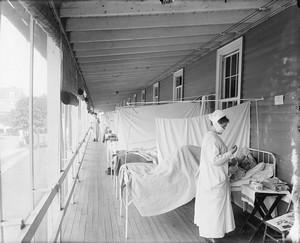1918 flu pandemicPossible European origin of the Spanish Influenza
What happens when a military historian and a virologist get together to discuss the 1918 pandemic? What you get is a fascinating insight into a possible European origin and all sorts of things we may have overlooked.

Treating patients of the Spanish flu // Source: commons.wikimedia.org
What happens when a military historian and a virologist get together to discuss the 1918 pandemic?
Pandora Report says that what you get is a fascinating insight into a possible European origin and all sorts of things we may have overlooked.
“When we reconsider the virology and history of the Spanish Influenza Pandemic, the science of 2018 provides us with tools which did not exist at the time,” John Oxford and Douglas Gill write in an article they published in Human Vaccines & Immunotherapeutics.
Two such tools come to mind. The first lies in the field of ‘gain of function’ experiments. A potential pandemic virus, such as influenza A (H5N1), can be deliberately mutated in the laboratory in order to change its virulence and spreadability. Key mutations can then be identified. A second tool lies in phylogenetics, combined with molecular clock analysis. It shows that the 1918 pandemic virus first emerged in the years 1915–1916.
We have revisited the literature published in Europe and the United States, and the notes left by physicians who lived at the time. In this, we have followed the words of the late Alfred Crosby: who wrote that “contemporary documentary evidence from qualified physicians” is the key to understanding where and how the first outbreaks occurred. In our view, the scientists working in Europe fulfill Crosby’s requirement for contemporary evidence of origin.
Elsewhere, Crosby also suggested that “the physicians of 1918 were participants in the greatest failure of medical science in the twentieth century”. Ours is a different approach. We point to individual pathologists in the United States and in France, who strove to construct the first universal vaccines against influenza. Their efforts were not misdirected, because the ultimate cause of death in nearly all cases flowed from superinfections with respiratory bacteria.
After a detailed analysis of the epidemic, its sources, and its ramifications, the authors conclude:
By 1946, the first killed whole virus and live-attenuated influenza vaccines had been tested in both the United States and the Soviet Union. By 1960, the HA and NA proteins of the influenza virus had been separated by ultracentrifugation, to make sub-unit vaccines. Such vaccines require formulation yearly and are not wholly effective.
